Here, in Siem Reap, it’s the looming temples of the roughly 700 year Khmer period of dominance in Southeast Asia. In Italy, it’s churches. In France or Germany, it’s castles. These are the endless number of attractions that a tourist wants to savor and often overconsumes.
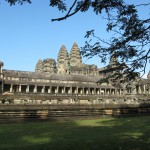
Hundreds of temples from the ancient capital of Angkor surround the modern town of Siem Reap, now swollen and frantic due to the millions of visitors annually, and so many are worth visiting: at times imposing, at times artistically breathtaking, and at times evocative of dominant empires felled by nature or war.
With the right guide, they are also primers of a culture worth understanding for it’s insights into the spiritual power of art and the conduct of life today in our own empire. Here are some things we learned in our visit.
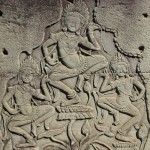
To start, it’s worth asking of these rulers why they devoted so much effort and time to building these monuments. The king had two main responsibilities to his people, none of whom were pledged to him as in feudal Europe, and for which they were willing to pay taxes or equivalent. First, he had to ensure the availability of water for the farms that sustained his population. That’s the part less visible here, but the royal engineers put as much effort or more into the vast reservoirs and canals that kept water flowing throughout rain and drought, as they put into the more visible temples of stone.
The king’s other responsibility was spiritual in nature, and the structures that satisified this less earthly requirement are what survive in stone, clay and brick today. The most impressive of the temples now standing were demonstrations of this royal power and the site of the highest level ceremonies; others fit more the needs of commoners.

We saw, for example, a set of single towers from the earlier capital of Koh Ker in the northeast. These were for villagers to pray and be blessed by holy water. The water was made sacred, in Hindu belief, by being poured over a bullet-shaped stone linga set in a square-cut stone yoni, and then channeled northward to priests waiting with the people outside the sacred temple.
The royal temples, however, were used for royal ceremonies and mainly designed, like western churches, to represent what entering heaven would be like. We’ve seen two sorts. The mountain temples include multi-tiered pyramids, intended to represent Mount Meru, the home of the Hindu deities. We’ve climbed a few of them now, and today they demand good wind, if not good spirit.

The forest temples, like the big ones at Angkor, feature complex rectangular geometries. The central temple sits at the intersection of colonnades or gated walkways that divide the square site into four parts, each of which can have two related sections. Given the scale of these, and the ruins, you can’t always feel the symmetries.
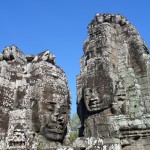
But even a bit of attention to the carefully situated towers of Angkor Thom, each of which projects four huge faces per the compass, shows how balanced overall is the design in both its grand structure and the details. The symmetries are most obvious at the most famous and extensively reconstructed site of Angkor Wat. There you enter along a central axis toward the main tower through a series of four rectangles, the last of which is a perfect square.
Ah the glorious details. You can spend day after day delighting in those that survived over time.
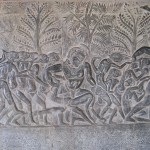
The elaborate bas-reliefs of Angkor Wat are astonishing for they intricately cover all 1600 feet of outer corridors, 7 feet high, telling stories from Hindu lore and of the king’s crowning victories. At Thom, it’s the deeper reliefs stacked three high that crown your visit. Then, most enchantingly, it’s the smaller scale fantasy world of the lintels and friezes of Banteay Srei some miles outside Seam Reap.
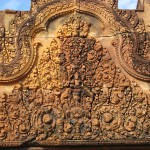
You know you’re in heaven, when you can still walk among these masterpieces. Or, like visitors a thousand years ago, when you are greeted over and over again by dancing angels, the carved apsaras that attend the Hindu deities on Mount Meru. Gazing upon the intricate artistry practiced by those master stone carvers of Angkor, you have no doubt that heaven lay in those details.
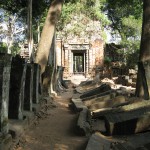
Oh yes, they had their tricks of turning masses of stone into visions of heaven, tricks you can see more in the still tumbled ruins of many temples rather than the painstaking reconstructions over time. How slightly overlapping stones shaped like monster gum erasers could stack into triangular arches that still perch peaked above us in our passage through the sites. How you could make a lot of figures with multiple layers like rock snowmen, with a cap of stone, a carved face, and weighty body. How you could secure roofing on columns in colonnades with carefully dug grooves, pegs and pegholes invisible except now. And so on.
But the spiritual trick was synthesizing the religious beliefs that came together in this area, first animism (believing spirits in nature), then Hinduism from India and then later Buddhism from Sri Lanka. Even the Hinduism merged and balanced options. Of the many gods, the kings typically celebrated the big three, Shiva the destroyer, Vishnu the protector/preserver, and Brahma the creator, rather than the more divisive idea of picking one to worship.

So, like so many of the lesser complexes, Angkor Wat has three temple towers, one to honor each god. The taller central tower flanked by the other two mimics they say the three fingers in the middle of the hand, but is taller to honor Vishnu (in the case of Angkor Wat) or more typically Shiva, the most powerful destroyer…of the bad things that can hurt you.
When Buddhism arrived, the Angkorians retained many of the architectural ideas for their new temples, adding elements rather than destroying the old. In the sixteenth century, one of the kings officially synthesized the religious beliefs to maintain what proved to be harmony lasting till this day. A modern Cambodian builds shrines that reflect their original animism, respect to the Hindu gods and of course Buddha as well. The distinctions don’t seem to matter much to them.
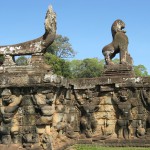
So the old symbols of the early Hindu Angkorians survive today in what might seem odd places. These are the ones that greet you at the entrances of all the ancient temples and all the new Buddhist ones: the lion of powerfulness and the many headed naga (snake) of happiness. For, this can be a good life, if you have the power to live it well and the blessing of happiness from it. And perhaps act like royalty, with responsibility for the spiritual and earthly well-being of all around you.
(For more pictures from Cambodia and Siem Reap, CLICK HERE to go to the Cambodia itinerary page and the slideshow at the end.)

